What do you mean by current up to 100W?
If off DBT and R1 was 30mV and R2 was 40mV, then if your R1 and R2 are correct at .56R and .47R respectively, the currents were 65mA and 85mA respectively. Not a lot of current.
As the "current" climbed up, did the voltage across R1 and R2 also climbed?
If off DBT and R1 was 30mV and R2 was 40mV, then if your R1 and R2 are correct at .56R and .47R respectively, the currents were 65mA and 85mA respectively. Not a lot of current.
As the "current" climbed up, did the voltage across R1 and R2 also climbed?
Ben, I realized you wanted Vgs for 0v R1/R2 on the DBT interestingly I see 31mv on Q1 and 3v on Q2
Sorry i get some of the terminology mixed up still.
I have a watt meter inline with the power supply.
I let it climb to 100w and saw the resistors climb to about 30mv across R1 and 40mv across R2.
I have a watt meter inline with the power supply.
I let it climb to 100w and saw the resistors climb to about 30mv across R1 and 40mv across R2.
So without DBT, the Watt meter showed 100W. Was that with both channels connected and powered up? If yes, was the other channel fully operational (fully biased and drawing design current)?
If your "bad" channel was only showing 30mV and 40mV without the DBT, you can probably resume the setup, slowly increasing the current and setting offset.
If your "bad" channel was only showing 30mV and 40mV without the DBT, you can probably resume the setup, slowly increasing the current and setting offset.
You're welcome.
New mosfets will not be exactly identical to previous mosfets. 🙂
New mosfets will not be exactly identical to previous mosfets. 🙂
So, I have “finished” up my f6 build but have run into a hum issue. A little background. I started up my power supply with dim build tester, had a simple issue. I had reversed the wires from the cap bank to the rectifier boards. Fixed that and LEDs lit and get constant +- 25 volts. Good. Connected left channel. Started up with dim bulb tester, no LED. It was reversed. Fixed that and started adjusting bias and offset. Set the bias around 250mv and offset down towards zero. Connected second channel and did the same as the first. I was using some cheap Amazon DMMs to test the offset and Amprobes to test the bias. Pulled out the dim bulb tester and started continue the climb to 500mV on both channels. The bias set to 520mV and is steady on both channels. The offset reading however fluctuates up and down +6mV to 0 to -6mV give or take a few +-mV. I changed meters around and played with settings and generated no constant measurement. So my thought was this was going to present as hum when I connected the f6 to source and speakers. It does. Hum gets louder as volume increases. I am using a 10k attenuator as a passive pre. Used many times in the past with no issue.
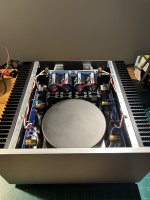
Any advice on where to start? I know this is squeezed into this enclosure. I would really prefer not to have to change enclosures if this is a proximity issue, adding shielding is definitely possible. The hum is really loud and the measurement on the output makes me think there is the same component issue on both channels.

Any advice on where to start? I know this is squeezed into this enclosure. I would really prefer not to have to change enclosures if this is a proximity issue, adding shielding is definitely possible. The hum is really loud and the measurement on the output makes me think there is the same component issue on both channels.
Can you show some pictures of the connections to the power supply, the signal wire connections and show/describe your ground lift from the chassis ground?
Also, does it hum when a single channel is connected and powered up versus both?
Do you have pictures of your passive preamp?
lastly, do you have a picture of your passive preamp?
Also, does it hum when a single channel is connected and powered up versus both?
Do you have pictures of your passive preamp?
lastly, do you have a picture of your passive preamp?
@Mikerodrig27 below is the IEC inlet and grounding. IEC ground to chassis, CL60 from ground point on power supply, transformer shield wire.
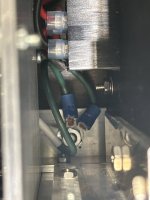
Here is the thermistors and cap. Red lead from IEC mains attached to one leg of red heat shrink CL60 and black lead to black.
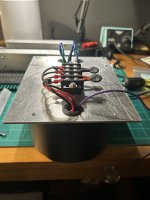
The following are the connections for one channel. They are the same for both. No shorts under boards.
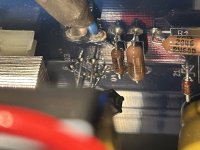
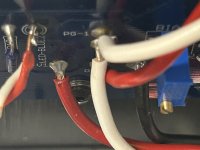
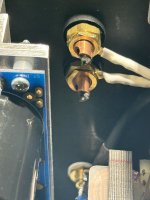
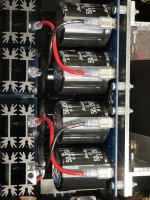
I have not tried to take one channel out yet. I am hoping to get a good starting point before I start taking things apart (if possible).
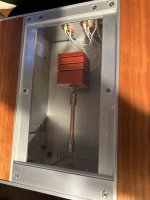

Here is the thermistors and cap. Red lead from IEC mains attached to one leg of red heat shrink CL60 and black lead to black.

The following are the connections for one channel. They are the same for both. No shorts under boards.




I have not tried to take one channel out yet. I am hoping to get a good starting point before I start taking things apart (if possible).

Have you tried bypassing the preamp? Possible to use a smartphone or other audio device with a volume control straight into the amp?
Your offset? check the resistance between your voltage supply and your heatsink (a screw or something) to confirm the connection is open for both the positive rail and the negative.
@Mikerodrig27 I will double check. @von Ah what I mean is the dc offset of the amp. The measurement does not drift around slowly over time. What I am saying is I am getting a different measurement every second. -6mV then zero then +6mV up and down sometimes the values will go up 10mV to 0 to -10mV then back to 6 etc. I have just not had an encounter with that rate of fluctuation on my DMM while taking a measurement.
Understood. Some amps fluctuate more than others in my limited experience. What you describe would not deter me from playing with different sources. However, I always use test speakers for these troubleshooting situations. I’ve found that my iPad’s headphone output is a pretty good test as a source. If it hums with the test speakers, I try to fix the hum source. If it doesn’t hum, or if the hum is minimal, I will move up to more risky auditions.
offset wandering - connect dummy load and it'll go steady
of course, when setting an amp, input(s) grounded
of course, when setting an amp, input(s) grounded
@Mikerodrig27 Amp off. diode bridge AC connections, no continuity to ground. V+ V- does have continuity to ground. Checked at connection to amp boards.Your offset? check the resistance between your voltage supply and your heatsink (a screw or something) to confirm the connection is open for both the positive rail and the negative.
- Home
- Amplifiers
- Pass Labs
- F6 Illustrated Build Guide